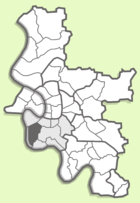Hamm (Dusseldorf)
|
Hamm district of the state capital Düsseldorf |
|||
|---|---|---|---|
|
|
|||
| Basic data | |||
| Geographic location : | 51 ° 12 ′ N , 6 ° 45 ′ E | ||
| Height: | 38 m above sea level | ||
| Surface: | 4.10 km² | ||
| Residents: | 4,399 (December 31, 2016) | ||
| Population density : | 1,073 inhabitants per km² | ||
| Incorporation : | 1394 | ||
| District: | District 3 | ||
| District number: | 034 | ||
| Transport links | |||
| Bundesstrasse : |
|
||
| S-Bahn : | S 8 S 11 P 28 | ||
| Tram : | 706 709 | ||
| Bus route: | 723 732 | ||
| Night traffic: | NE 8 | ||
The Düsseldorf district of Hamm is located in the Rheinbogen south of the city center in district 3 . The name comes from the Latin word Hamus (Eng. Hook), which refers to the location of the place in this very bow or hook of the Rhine. With around 4,400 inhabitants (as of December 2016), Hamm is one of the smallest districts in Düsseldorf. In order to distinguish the Düsseldorf district of Hamm from the city of Hamm , it is also often referred to as Kappes-Hamm ( Kappes = cabbage in the Düsseldorfer Platt ).
location
Despite its rural location, the district is directly adjacent to the Düsseldorf Medienhafen and the suburbs of Unterbilk and Bilk . It's barely ten minutes by bike or car to Düsseldorf's old town or city center. The direct transport connection to the Rheinufertunnel enables a journey time of around 15 to 20 minutes to Düsseldorf Airport . Heinrich Heine University , which is also located in the south of Düsseldorf like Hamm , can be reached by car in around ten minutes. In public transport (PT) Hamm has a tram connections (lines 706 and 709) and a train - breakpoint (S8, S11 and S28). The 723 bus has also been running there since 2016.
history
Hamm was first mentioned in a document by 1218 at the latest. However, there are also reports of first mentions from the years 793 and 875. One of the oldest sources about Hamm is the document dated June 23, 1347 about the farms in Hamm. The medieval script, written in Latin, is in the main archive of the state capital Düsseldorf .
In the more than 600-year history of the small district, more than eight severe floods can be documented. In 1394, the parish of Hamm was incorporated into the city of Düsseldorf by Duke Wilhelm I and the residents were given "urban freedoms". Furthermore, the residents are promised "freedom of expression" for 24 years.
The “St. Sebastianus Schützenbruderschaft “Düsseldorf-Hamm is one of the oldest historical rifle brotherhoods in Düsseldorf. With the invasion of Brandenburg troops in 1644, the Thirty Years' War began for the Düsseldorf district . Nowadays the Catholic parish church St. Blasius , which was rebuilt in 1911, shapes the townscape. The two chapels in Hamm are older than the parish church. In 1709 the construction of the Rochus Chapel at the lower end of Fährstrasse was commissioned. The Chapel of the Cross , donated by Count Palatine Philipp Wilhelm for the birth of Prince Jan Wilhelm, is even older . The chapel, built from 1658 to 1660, is used today by the Orthodox community in Düsseldorf.
For many years a Rhine ferry operated between Hamm and Neuss , which was first mentioned in 1453. Nowadays you can cross the Josef-Kardinal-Frings-Brücke on Bundesstrasse 1 and the Hammer Eisenbahnbrücke on dry feet to the other side of the Rhine.
Since 1992 the Förderverein Düsseldorf-Hamm eV has been campaigning for the interests of the citizens of Hammer at the local level.
School and kindergarten
The first school in Hamm was inaugurated in 1824. Due to the increase in population at the turn of the century, it was decided to build a larger school building at the same location. The school building, which was badly damaged in the Second World War and restored in the following years, is still used as the municipal Catholic primary school (KGS). The style of the school building is still reminiscent of the typical Wilhelmine architecture.
Since 1960 there has also been a Catholic kindergarten in Hamm.
economy
In the fertile floodplains on the Rhine, the Hammer "Kappesbuure" (translated cabbage farmers) mainly cultivated cabbage and vegetables for the people of Düsseldorf. Until the middle of the 20th century, the hammer asparagus in particular was known far beyond the borders of Düsseldorf. In the meantime, flower planting dominates agriculture.
In addition to the historically grown and now declining agriculture, many businesses settled in the craft sector. There are also three hotels and several restaurants and other service companies in Hamm.
Web links
Individual evidence
- ^ Office for statistics and elections of the state capital Düsseldorf: Statistics for the district 034 - Hamm
- ↑ Lacomblet, Theodor Joseph, in: Document book for the history of the Lower Rhine or the Archbishopric of Cologne, Certificate No. 1001 , 1853, Volume 3, p. [899] 887. Digitized edition ULB Bonn
Remarks
- ↑ In older publications on the first chapel in Hamm, the name of the settlement “Ungesham” is also given. Lacomblet locates this place, however, near Ehingen and Huckingen at the "Ungelsheimer Graben". Proof: Lac. I. in note on document no.540 from 1193.



